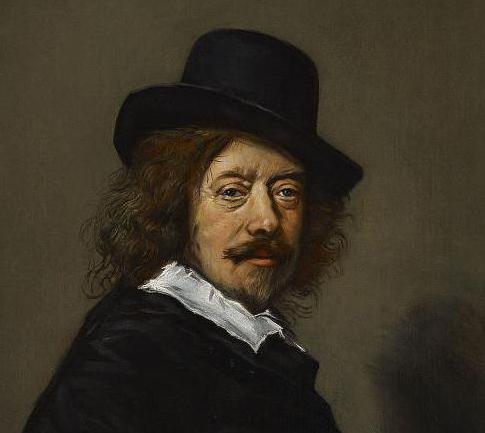Frans Hals (1582-1666) is one of the greatest portrait painters of the golden age of Holland art. He was very popular, he had many orders and students, but the artist died in complete poverty in a shelter for the poor. This is how the life of a genius has developed.
Frans Hals: biography
A little less than four hundred years separate us from the life of a great artist. But little is known about him personally. His father was a weaver in Antwerp, married a second marriage, in which Frans Hals was born. Then the family moved to Haarlem, which is about twenty kilometers from Antwerp. At the time of his birth, there was no peace in his homeland. Spanish troops besieged the city, stormed, ravaged. Immigrants fled to Haarlem from all directions. The city grew rich and began to show great interest in art. Therefore, probably, Frans Hals almost never left Harlem. Having studied the profession, adopted in the guild of St. Luke, which at that time was an analogue of the Academy of Painting, the young Hals becomes a restorer for starters.

Six years later, he gains fame as a portrait painter. And a year later he will marry. Five sons will be born in the marriage, and all will follow in the footsteps of their father - they will become portrait painters. The peak of the popularity and heyday of the work of a genius falls on the years 1620-1640. But then they begin to forget him. So goes the glory of a painter named Frans Hals. Pictures almost do not order. Poverty is approaching, which leads the master to an almshouse. In it, he dies. In the Hermitage you can see two male portraits painted by the great artist.
Portrait of the Unknown (1650-1652)
The mean colors that Frans Hals comes to these years, allows you to fully focus on the face of the person depicted. The wide white collar of the model draws attention to the expression even more. A well-groomed man with long curled hair and a mustache calmly and confidently stares at the viewer.
He is wealthy and independent, mocking and, perhaps, full of aplomb. His posture is natural and laid-back. No perturbations in life threaten him. He clearly knows how to cope with any life situations. The portrait does not give the impression of a frozen, static. The artist receives this dynamic effect due to the fact that the model is close to the viewer, the look is directed directly to him, and the elbow of the hand on which the portrait is based is advanced. She "torn" a flat canvas. It was a step forward to the future from the portraiture of his time.
Portrait of a young man with a glove in his hand (1650)
The model gives the impression of calm self-confidence and cheerfulness. The look directed at the viewer is full of attention, interest and goodwill.
A slight smile plays on the lips. Noticeable thick strokes of undiluted paint simply “molded” the face of the model. The same technique is written white lace collar, lighted hair and a glove. But the background and shadows are written in translucent paint. Thus, the figure protrudes in relief from the canvas and approaches the viewer. All movements of the brush are accurately and skillfully calculated. This has achieved the creation of a complete image.
Portrait of Isabella Coymans (1689)
Without going deep into psychologism, the artist Frans Hals writes a young chubby, pretty, benevolent and simple-minded woman. This is a wealthy customer, and the painter applies all his skill to show jewelry and lush expensive clothes. With extraordinary diligence, the lace of the collar and cuffs was written out. Satin bows and ribbons shining decorate the belt and collar of the model, as well as translucent ribbons in her hair.
The pearl necklace on the slender neck and the bracelet on the graceful hand that holds the rose are flickering. It is impossible to look away from the satin of the dress, which is decorated with a light insert with lace on the hem. The portrait is made in golden brown tones. The rich nuances of the colors of the dark dress and
light background, the play of shadows make the model convex, protruding from the plane of the picture. Despite all the parade, the portrait has not lost its democratic character. It is in a private collection.
"The head of a boy in a beret" (1640)
Close-up of a child’s head placed in a circle on a golden light background. The circle immediately completes the portrait.
The attentive look of the brown-eyed child is directed at something curious up and to the right. The artist reflects the moment, the living moment of life. He grabbed it and transferred to the canvas. The left part of the face is in the shadow, which allows you to more clearly fashion the oval of a young face and chin with a dimple. The right, illuminated by light, plays a blush. The bright lips of a beautiful figure are tightly compressed. The face is framed by light golden waves of short hair. Their large curls descend low on the forehead, showing the beauty of the shape of the eyebrows. A low bluish collar and a white frill open a slender neck. Hair and beret repeat the originally given circle shape. The work is in a private collection in London.
In this article we tried to place the master’s works known and unfamiliar to the public. Feelings, emotions, intelligence, and not a ceremonial costume, the painter first of all tried to convey. And therefore, the artist turned his attention to facial expressions, gesture, pose. His artistic heritage, which is mainly located in his homeland, has far gone beyond its borders.